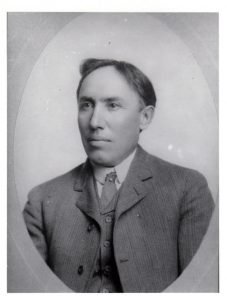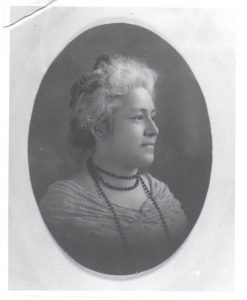Andrew Dawson
Compiled by Joyce Clarke Turvey from the Martha Edgerton Plassman Papers
The pioneer of the Dawson family in Montana was Andrew, a name that was to become well known in the Northwest. He was born on April 25, 1817 at Dalkeith, Scotland, a celebrated and ancient town in the most fertile part of County Midlothian. In his boyhood, he joined all the happy pursuits of his companions with zest, in which he was invariably chosen as the leader. He was said to have been light complexioned and freckled, with blue eyes and hair of a chestnut hue. He grew to be six feet tall and was of a sturdy build.
As a youngster he had a velocipede [either a unicycle or bicycle], on which he became an expert rider, so much so that he grew somewhat reckless. One day, while riding down a steep street, he descended at such a speed that he could not avoid striking a rock. The unexpected contact sent him flying through the air with such force that he suffered head injuries from which he was disabled for several months.Upon completing his basic schooling, Andrew served an apprenticeship with his uncle, Ralph Scott, a well-born lawyer and accountant in Edinburgh. While thus engaged, he also studied under the University professors, his favorite subjects being law (or logic), chemistry and philosophy. On completing his apprenticeship, he accepted a post as confidential clerk (or secretary) with a large manufacturing firm in England. However, he did not stay long as he found the English ways distasteful and the business too confining, and decided to leave the country.
In 1843, young Dawson set sail from Liverpool for New Orleans, where he took the first steamer for St. Louis. Though penniless on arrival, he soon obtained employment and made many acquaintances, among them some Scotchmen from whom he heard much of the free and adventurous fur-trading life in the Northwest. As a result, after a year in St. Louis, he set forth with a companion in the direction of what is now Montana.
After many hardships, he reached Fort Pierre on the Missouri and shortly thereafter arrived at Fort Clarke, where he spent several years. There he met Pierre Garreau, the noted scout, and acquired a thorough knowledge of hunting, trapping and trading with the Indians. Here too he met and married Josette, a daughter of Pierre, who became the mother of his oldest son James.
When he moved up the Missouri to Fort Union, he made the acquaintance of Alexander Culbertson who shortly after that engaged him to go to the Fort Benton port in 1856. One of his first assignments there was converting the wooden fort into a brick fortress as a safeguard against the Indians. It was he who, because of his friendship with Senator Thomas Benton, suggested that the post be renamed Fort Benton.
Under his management, the business of the American Fur Company at Fort Benton prospered and he became one of the chief partners. In 1858 he suffered a misfortune – a severe fall, which left his arm partially crippled. It was an injury that made him weaker every year until he had practically lost the use of his legs and decided to retire. In the summer of 1864 he handed over the fort and the good will of the business to Carroll and Steel, his two chief clerks, and set sail.Dawson landed in Liverpool that autumn, and returned to his old town of Dalkeith where he lived for a time with his brother Ebenezer. Later his son, James, moved him to a private boarding house where he managed to survive until his death on September 16, 1871.
In the course of his twenty years on the upper Missouri, Dawson acquired a succession of Indian spouses. As mentioned, at Fort Clark, ND he married Josette, and she became the mother of James. Mary Scott, a Brule Sioux, gave birth to his second son, Andrew, probably at Fort Union. And Pipe Woman, a Gros Ventre, was the mother of his youngest son, Andrew, who was born in 1859 at Fort Benton, MT.
James and Thomas were educated in Scotland while Andrew was placed in the care of Robert Morgan, an old friend who lived at Fort Garry, Manitoba, Canada. The naming of Dawson County after him, in the eastern part of the state [MT], evidences the importance of Andrew Dawson’s role on the early Montana scene.




